Key takeaways:
- Selective mutism is an anxiety disorder that affects children’s ability to communicate in certain environments, requiring understanding and support from caregivers and educators.
- Early recognition of signs, such as contrasting communication behaviors in different settings, is vital for effective intervention.
- Identifying personal motivators and utilizing evidence-based approaches, such as cognitive-behavioral strategies, can foster better communication and confidence in children.
- Building community support and advocacy is essential for raising awareness and creating inclusive environments for children with selective mutism.
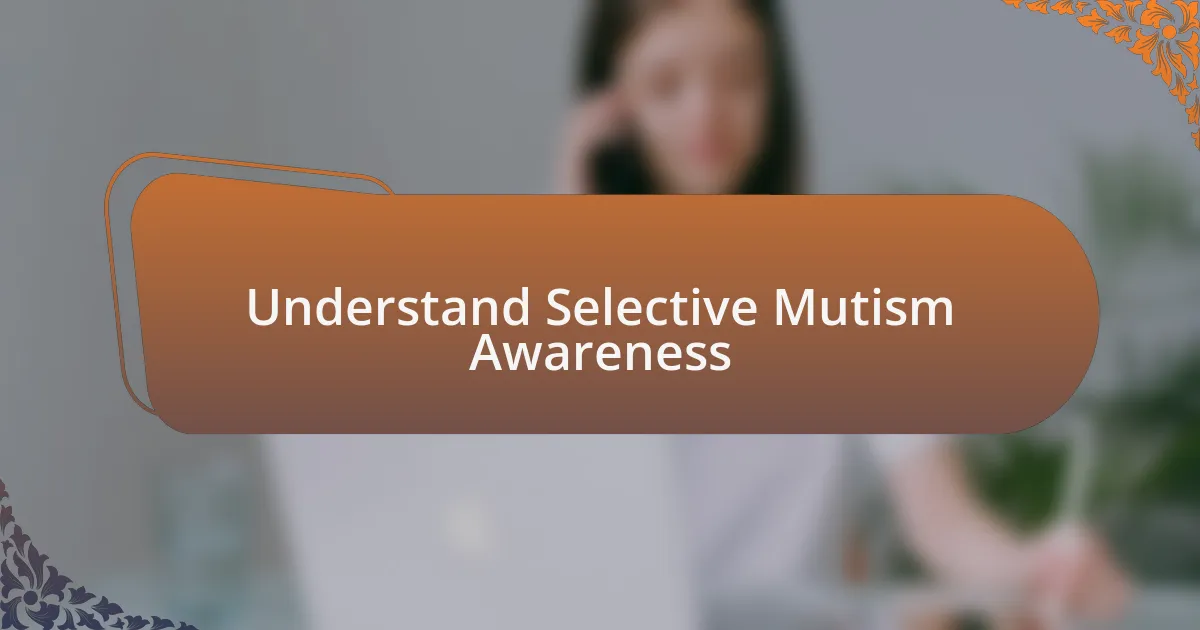
Understand Selective Mutism Awareness
Selective mutism is more than a reluctance to speak; it’s an anxiety disorder that can cause children to feel trapped in silence. I remember meeting a young girl who thrived in her safe spaces but clammed up in school. It was heartbreaking to witness her struggle, and it made me wonder, what would it take for her to find her voice in a world that felt so overwhelming?
Awareness of selective mutism helps us peel back the layers surrounding this often-misunderstood condition. It opens the door for empathy and support, allowing caregivers and educators to create environments where children can flourish. Have you ever considered how a simple shift in approach could make a world of difference for a child facing this challenge?
The emotional weight that accompanies selective mutism can be heavy, not just for the child but for the entire family. I’ve seen families experience a mix of frustration and hope as they navigate the complexities of communication. It raises an important question: how can we, as a society, foster more understanding and create supportive communities for those affected by selective mutism?
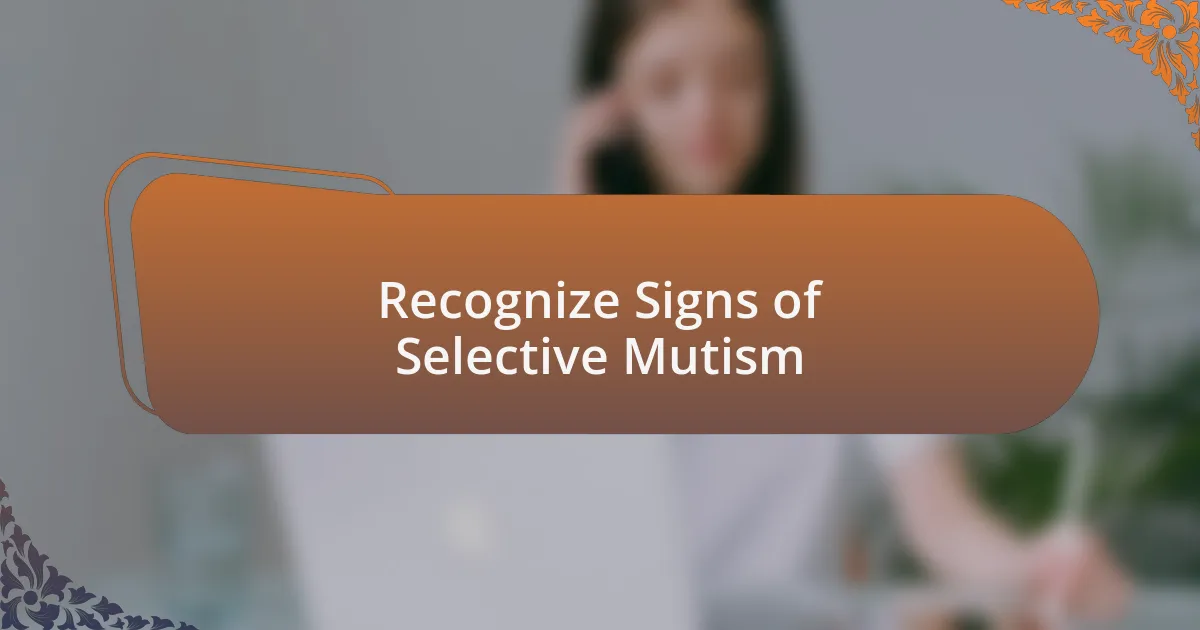
Recognize Signs of Selective Mutism
Recognizing the signs of selective mutism is crucial for early intervention. I once observed a child who would chatter away at home but completely shut down in social settings, blending into the background with an anxious expression. This stark contrast made me realize how vital it is for caregivers to understand the different environments that trigger a child’s communication barriers.
Many children with selective mutism may exhibit body language that speaks volumes; they might avoid eye contact or fidget nervously when asked to speak. I recall a parent sharing their frustration when their child would nod silently instead of responding verbally, leaving the adults feeling helpless. Have you ever felt that sinking feeling of wanting to help but not knowing how? This can be a common experience when dealing with selective mutism.
Another key sign to watch for is a child’s tendency to engage more with familiar adults or in familiar environments. I once saw a child effortlessly interact with their grandmother, showcasing how comfort plays a role in communication. When a child shows an ability to express themselves in certain settings, it highlights the importance of creating supportive spaces that encourage them to find their voice in challenging situations.
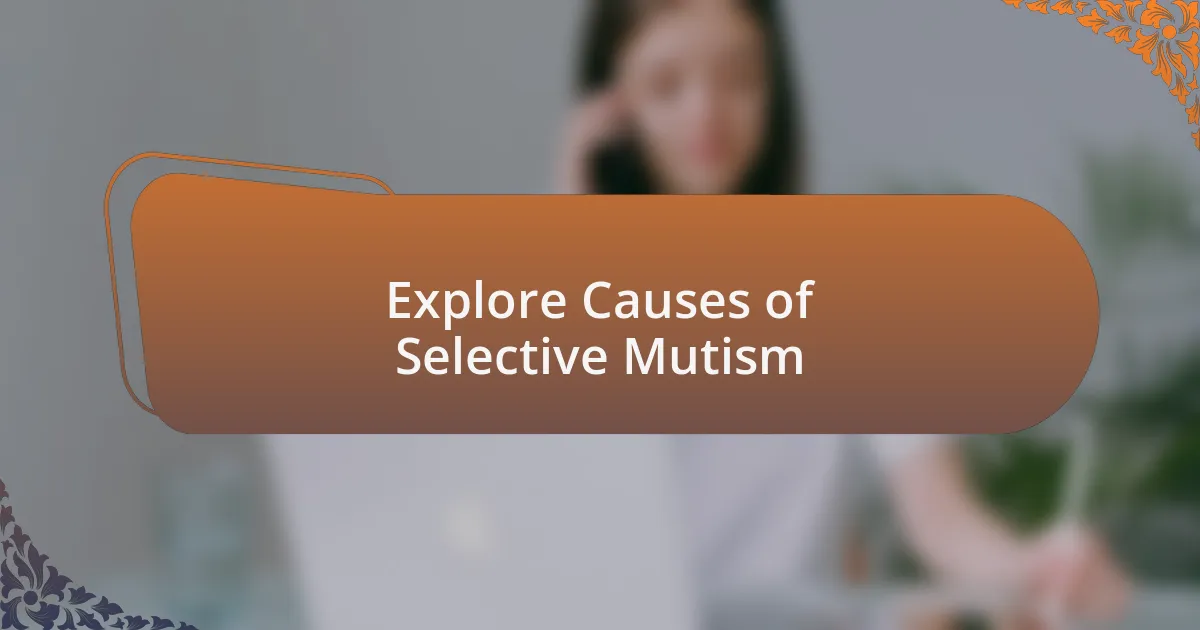
Explore Causes of Selective Mutism
Understanding the causes of selective mutism can shed light on how to support children facing this challenge. In my experience, anxiety often plays a significant role; I once worked with a child who seemed perfectly fine at home but froze completely in unfamiliar settings. It made me ponder—how does a place we’ve never been before feel so daunting to a child who is usually so lively?
Another contributing factor is the child’s temperament. Children who are naturally shy or introverted may struggle more with speaking in public. I remember a parent sharing how their little one would light up during playdates with friends but quickly retreat into silence around new people, leaving everyone wondering what was left unsaid. It’s a chilling reminder of how even those with vibrant personalities can feel trapped when faced with social pressures.
Additionally, environmental influences can play a crucial role. For instance, I’ve noticed in some cases that if a child observes adults being anxious or awkward in social situations, it can reinforce their own fears. I once saw a child mirror their parent’s nervousness at a party, which led me to question how much our behaviors shape the experiences of the young ones around us. If we recognize and address these causes, we can create pathways for better communication.
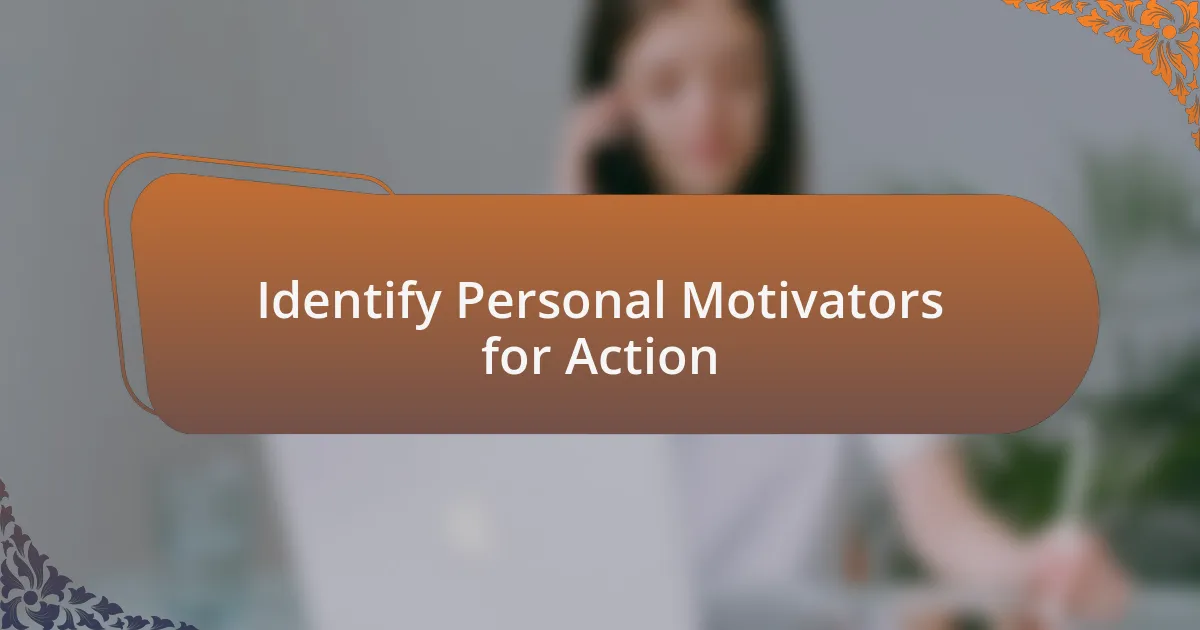
Identify Personal Motivators for Action
Identifying personal motivators for action can be a powerful step in overcoming selective mutism. For example, I once knew a child who discovered a love for art. Whenever she was encouraged to express herself through drawing, it was as if her voice came alive on paper. This realization made me wonder—could finding a passion be a gateway for children to connect their emotions with spoken words?
Understanding what drives a child can sometimes be as simple as exploring their interests. I remember working with a boy who was hesitant to speak during group activities, but when we introduced a game that involved his favorite dinosaurs, he suddenly found his voice. It was fascinating to see how something he loved could transform his reluctance into enthusiasm. What if we all took the time to find those unique triggers that inspire children to break free from their silence?
Additionally, recognition and encouragement from trusted individuals can spark motivation. There was a situation where a student, who rarely participated in discussions, received specific praise for sharing a thought about a book they loved. The joy on their face was unmistakable and led them to participate more frequently. It makes me reflect: how often do we recognize and celebrate small victories, and could this practice foster a more supportive environment for children facing these challenges?
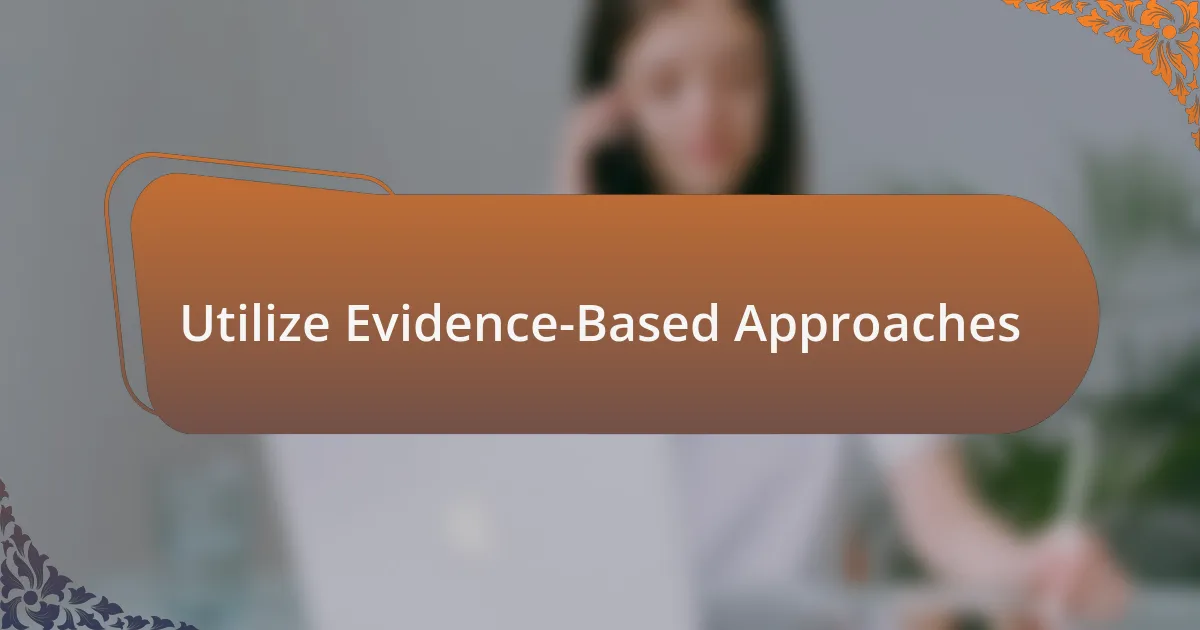
Utilize Evidence-Based Approaches
Utilizing evidence-based approaches when working with children with selective mutism is crucial for effective support. I recall a workshop focused on cognitive-behavioral strategies that emphasized gradual exposure. One of the key activities involved role-playing, which allowed participants to practice speaking in a safe and controlled environment. It made me ponder: how could incorporating these low-pressure techniques empower children to gradually express themselves in everyday situations?
In my experience, data-driven techniques like the use of positive reinforcement have yielded significant results. I vividly remember a case where a child received tokens for each time they spoke, which they could exchange for rewards. Watching their confidence grow with each token collected was inspiring. It’s fascinating how a system that acknowledges effort can create a ripple effect on a child’s willingness to participate socially.
We must also consider the power of parent and teacher training in using these methods effectively. I’ve seen profound changes when educators were equipped with tools to foster communication, such as modeling language and maintaining a supportive atmosphere. It raises a question: how often are we investing in the knowledge of those who interact daily with these children? Fostering a collaborative environment can amplify the impact of evidence-based approaches significantly.

Share Personal Experiences and Stories
Sharing personal experiences that highlight the journey through selective mutism can be powerful. I remember a parent who shared their story about their child’s first day at school, where silence filled the room. The child, gripping their backpack, looked around with wide eyes, reflecting a mix of anxiety and determination. Hearing how they gradually broke this silence through small, supportive interactions touched me deeply. It made me wonder: what if we celebrated these small victories more openly?
Another story that stands out is from a teacher I spoke with who implemented a “silent buddy” system in her classroom. One particularly shy student would only communicate with their buddy through notes at first. Over weeks, I watched as this child’s interactions grew—first with their buddy and then, slowly, to the entire class. It’s a testament to how safe connections can pave the way for broader engagement. Have you ever experienced the magic of a gradual bond leading to newfound confidence?
I also recall the heartfelt moment when a young girl recited a poem during a school assembly after months of silence. Her parents were in tears, and I could feel the room’s energy shift; it was electric. It raises a poignant question: how can we cultivate environments that make such moments possible? Sharing these stories isn’t just about communication; it’s about expressing the innate human desire to connect, reflect, and inspire others on similar paths.
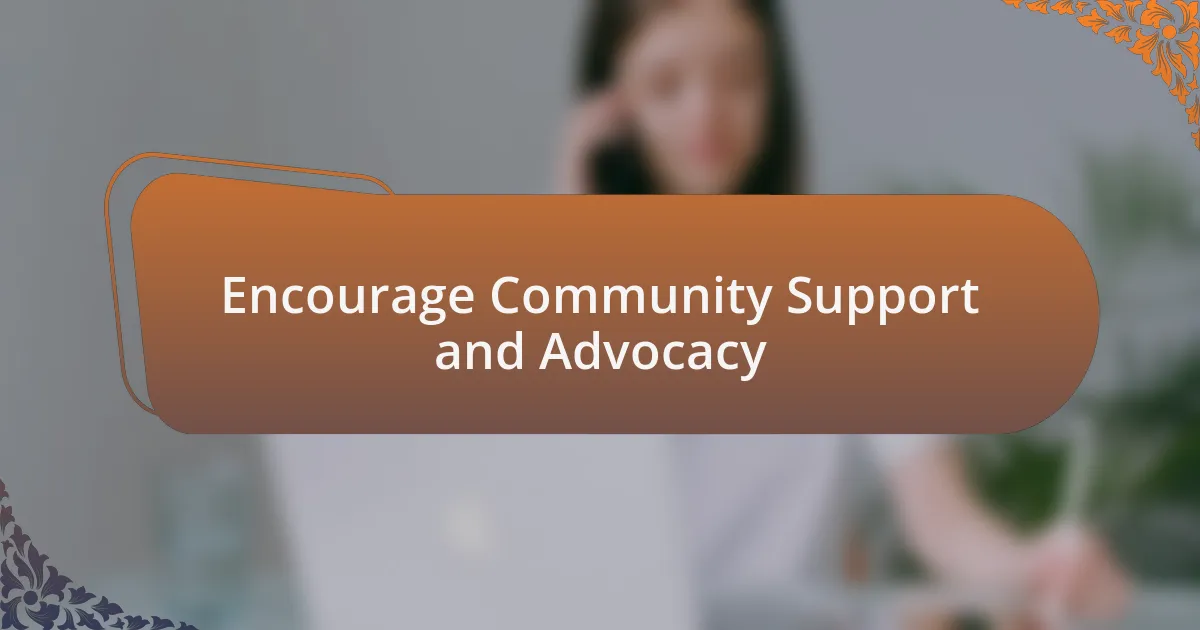
Encourage Community Support and Advocacy
Building a supportive community around those affected by selective mutism is crucial. I remember attending a local support group where parents gathered to share their experiences. It was astonishing to see how these interactions not only provided comfort but also inspired individuals to advocate for their children with local schools. I often think: isn’t it empowering to know that we can collectively influence change when we unite for a common cause?
Advococating for awareness in schools is especially important. I once met a passionate volunteer who organized workshops for educators, helping them understand how to engage students with selective mutism effectively. The feedback from teachers was enlightening; they appreciated learning strategies that created more inclusive environments. I can’t help but ask: how can each of us take initiative to bridge the gap between understanding and action in our communities?
Establishing community awareness campaigns is another avenue for advocacy that I find exciting. I was part of an event where families shared their stories publicly, drawing attention to the nuances of selective mutism. The audience was visibly moved, which made me realize how essential it is to bring these experiences into the spotlight. Have you thought about how sharing our collective voice can inspire those who might be struggling quietly?